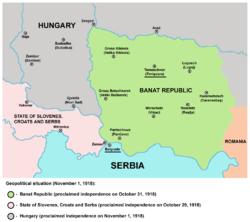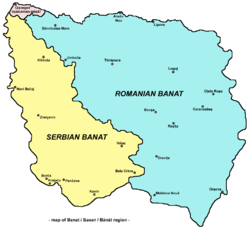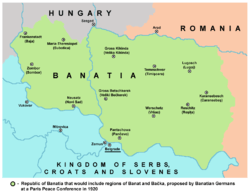Banat Republic
| Banat Republic | ||||||||||||
| Republica Bănățeană (Romanian) Banater Republik (German) Banatska republika (Serbian–Latin) Банатска република (Serbian–Cyrillic) Bánáti Köztársaság (Hungarian) | ||||||||||||
| Unrecognized state | ||||||||||||
| ||||||||||||
| Banat Republic superimposed over modern-day borders. | ||||||||||||
| Capital | Timișoara | |||||||||||
| Government | Republic | |||||||||||
| President | Otto Roth | |||||||||||
| Historical era | World War I | |||||||||||
| • | Proclaimed | 1 November 1918 | ||||||||||
| • | Suppressed by Serbia | 15 November 1918 | ||||||||||
| ||||||||||||
The Banat Republic (Romanian: Republica Bănăţeană, German: Banater Republik, Serbian: Banatska republika / Банатска република, Hungarian: Bánáti Köztársaság) was a short-lived state proclaimed in Timişoara on November 1, 1918, the day after the dissolution of the Austro-Hungarian Empire. Recognized only by Hungary, the republic was invaded by the army of neighboring Serbia on November 15. The next year, its territory was divided primarily between the Kingdom of Serbs, Croats and Slovenes and Romania.
Origins
The Banat is a natural geographical region in the Pannonian plain. From 1552, it was an Ottoman province named the Eyalet of Temeşvar. After the 1718 Treaty of Passarowitz, the region became a Habsburg province called the Banat of Temeswar. This province was abolished in 1778. Between 1849 and 1860, the Banat region, together with the Bačka and Srem, was part of a new Habsburg province, the Voivodship of Serbia and Tamiš Banat. The capital of all these provinces was Timișoara.
History
| Serbian invasion of Banat | |||||||||
|---|---|---|---|---|---|---|---|---|---|
| Part of Revolutions and interventions in Hungary (1918–20) | |||||||||
| |||||||||
| Belligerents | |||||||||
| Banat Republic |
| ||||||||
| Commanders and leaders | |||||||||
| Otto Roth |
| ||||||||
| Strength | |||||||||
| Unknown | Unknown | ||||||||
| Casualties and losses | |||||||||
| Unknown | Unknown | ||||||||
On October 31, 1918, military councils were established by the ethnic groups living in the Banat region: Romanian, Hungarian, German, Jewish and Serb. At a meeting, Dr. Otto Roth, a member of the Social Democratic Party, proposed the creation of an autonomous Banat People's Council, with representatives from each ethnic group, but Romanian officers distanced themselves from this objective as long as there was no resolution on the matter from the Romanian National Council.


The leading members of the Social Democratic Party decided however to proclaim the republic the day after, and on November 1, 1918, Roth proclaimed the Republic of Banat from the balcony of the Timișoara local council. The civil leader of the Republic was Dr Roth, while the military commander was the Hungarian Albert Bartha (who would also serve as Minister of Defense of the Hungarian Democratic Republic starting with November 9, 1918). The government of Hungary recognized the independence of the Banat Republic.
The same day, the founding meeting of the Banat People's Council took place, with 20 members drawn from the city council, 60 members from the military national councils, 40 representatives from the workers councils, and 70 from the bourgeois parties. An executive committee of 20 members was elected.
However, the Romanians, the largest ethnic group, did not want autonomy, but rather unification with Romania.[1]
The Banat National Council organized military squads and a civil guard on November 4 to establish control over the territory of the Banat. However, on November 15, Serbian troops entered the Banat and put an end to the Republic. The national councils were dismantled by the newly formed Serb-Croat-Slovene administration on February 21, 1919. A few months later, following the Alba-Iulia Resolution and Great People's Assembly in Novi Sad, the Banat region was divided primarily between Romania and the Kingdom of Serbs, Croats and Slovenes.

On April 16, 1920, ethnic Germans from the Banat sent a request to the Paris Peace Conference asking for the re-establishment of the Republic as the Republic of Banatia, this new republic to include not only the Banat, but also the neighbouring region of Bačka. The republic would be divided into cantons, each administered by the plurality or the majority ethnic group. However, this proposal was rejected.[2]
Population
The population of the republic was 1,582,133, of which 592,049 (37.42%) were Romanians, 387,545 (24.50%) Germans, 284,329 (17.97%) Serbs, and 242,152 (15.31%) Hungarians, with smaller numbers of other ethnic groups such as the Slovaks, Croats, Banat Bulgarians and Rusyns. The religious composition was as follows: 855,852 (54.10%) were Orthodox Christians, 591,447 (37.38%) were Roman Catholics, with a scattering of adherents of other religious groups such as Calvinists, Lutherans and Jews.
Notes
- ↑ Richard Weber, Die Turbulenzen der Jahre 1918–1919 in Temeschburg (German)
- ↑ Milojko Brusin, Naša razgraničenja sa susedima 1919-1920, Novi Sad, 1998.
Further reading
- Drago Njegovan, Prisajedinjenje Vojvodine Srbiji, Novi Sad, 2004.
- Milojko Brusin, Naša razgraničenja sa susedima 1919-1920, Novi Sad, 1998.
See also
| Wikimedia Commons has media related to Banat Republic. |
